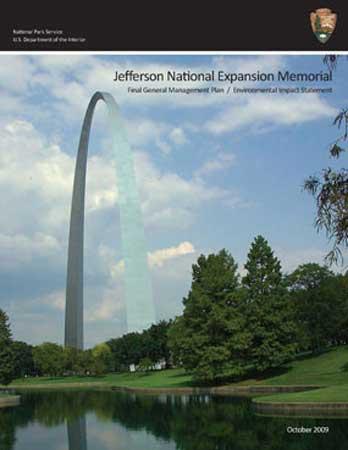It's taken nearly two years and created more than a little controversy, but the final General Management Plan for Jefferson National Expansion Memorial in St. Louis (which includes the "Gateway Arch") has been completed and released for public review. What happens next?
A General Management Plan is a long range "master plan" prepared for units of the National Park System; the plan for this park was last updated in 1962. The effort to update the document for this park began in early 2008, in the midst of proposals by local business leaders to make some major changes in the park.
The park has issued a news release that summarizes what's taken place during the past two years:
Since the process started, National Park Service (NPS) staff members have conducted an extensive public involvement and outreach program, meeting with nearly 1000 people in 11 public informational meetings. The Final GMP/EIS was crafted from the valuable public comment received on the draft plan, and includes revisions to the preferred alternative based upon this input.
Superintendent Tom Bradley said,
"Interest in the General Management Plan for the memorial has been high, and St. Louisans have displayed an incredible knowledge of the site and its future possibilities. I have nothing but admiration and appreciation for the suggestions, comments and encouraging dialog we have had with the people of St. Louis and the surrounding area on this plan.
Working together, we have achieved a balance between the restrictions of our National Historic Landmark status and the potential of the site to make connections with the city and Illinois side of the river, while at the same time improving the visitor experience. We now look forward to an exciting design competition as part of the preferred alternative, which will provide unique and creative solutions to current problems and add dynamic new elements to the park."
Copies of the plan are available online; the document is divided into several sections, including an Executive Summary.
Here are a few highlights from that summary, contingent upon final approval of the "preferred alternative" identified in the plan. Keep in mind this plan is intentionally a general, long-range document, not a specific plan for individual projects, so it provides considerable latitude for future activities:
• The Memorial would be revitalized by expanded programming, facilities, and partnerships;
• A design competition, akin to the 1947 competition held for the initial development of the site, would be initiated by the NPS in close coordination with partners. This competition seeks to gain the widest breadth of ideas for expanding interpretation, education opportunities, and visitor amenities at the Memorial.
• Funding for the competition and any resulting development would come in stages, and would likely be provided by partners, donations, and other non-federal and federal sources. Private funding would be required in order to implement the winning entry of the design competition;
• Educational and interpretive programs currently offered at the Memorial will be expanded;
• The grounds surrounding the Gateway Arch would be managed to accommodate and promote more visitor activities and special events than are currently provided;
• The NPS would actively coordinate with the City and State to enhance the pedestrian environment around the Memorial by developing a unifying streetscape along the Gateway Mall and the other streets adjacent to the Memorial; pedestrian access between the Memorial and surrounding areas would be improved;
• A new east portal linking East St. Louis to the Gateway Arch grounds by water taxi would be established;
• Any new above ground structures would be limited to specific parts of the Memorial grounds;
• The NPS would not allow the implementation of a project that would cause impairment to the Memorial, and all of the enhancements would be required to be located in such a manner as to preserve the integrity of the National Historic Landmark and National Register Historic District.
So, what does all this mean? The plan is general enough to satisfy many of the local concerns, affords protection for the core central area around the Arch, and avoids specific endorsement of the most controversial development pushed by some business interests. The broad language also allows a lot of latitude for decisions that will shape the park in coming decades.
Local reaction to the plan has been generally favorable. An article in the St. Louis Post-Dispatch was titled "Gateway Arch Plan Gets a Thumbs-up," and included positive quotes from the mayor; the area's congressional delegation "endorsed the document in general terms."
Former U.S. Senator John C. Danforth, one of the proponents of expanded development of the Arch grounds and of greater commercial activity in the area, withdrew from active participation in the planning process earlier this year.
So, what happens next?
Following distribution of the plan and a 30-day no-action period, a "Record of Decision" will be signed by Superintendent Tom Bradley and NPS Regional Director Ernest Quintana documenting the selection of the alternative to the implemented.
Once that formality is completed, whether any significant changes actually occur at the park will hinge largely on funding…and philosophy. As is often the case in General Management Plans, there will be likely more debate in years ahead on how to interpret and apply the broad language contained in this document.




Add comment